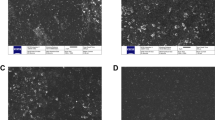Abstract
Newly developed dental composite materials contain increased concentrations of filler particles of the nanometer size to produce materials with high mechanical and wear resistance, improved polishability, and long-lasting gloss. With nanocomposites, however, a question arises on possible health risk caused by filler nanoparticles released during finishing and polishing nanocomposite restorations in dental cabinets. As data in the current literature are conflicting, our study was focused on detailed characterization of aerosol particles released during grinding nanocomposites Filtek Ultimate and Estelite Sigma Quick by diamond and tungsten carbide bladed burs. The results were compared with the aerosol particle size obtained from a composite Charisma reinforced with micrometer-size filler particles and an unfilled resin. Using a scanning mobility particle sizer and aerodynamic particle sizer, the release of nano- and micro-sized particles generated during high-speed grinding was detected. The mode of nanoparticle size distribution ranged not only from less than 16.0 to 51.6 nm for both nanocomposites, but also for the microhybrid composite and the unfilled resin. However, the amount of nanoparticles in the aerosol (5.0–68) × 103 cm−3 was not high exceeding 1–8.5 times their background concentration. The release of nanoparticles independently on the filler particle size and their content might suggest that the aerosol nanoparticles may originate from thermal decomposition of composite polymeric matrix due to friction heat rather than from filler nanoparticles. Due to the potential adverse health effects of nanoparticles, more detailed research is needed to investigate the effect of finishing conditions on the nanoparticle generation and their chemical composition to avoid any potential risk to dental staff. A study of the aerosol formed during grinding with water cooling to avoid heating will also be carried out.
Graphical abstract






Similar content being viewed by others
References
Rawls HR, Esquivel-Upshaw JE (2003) Restorative resins. In: Anusavice KJ (ed) Phillips science of dental materials. Saunders Elsevier, St. Louis, p 399
Stansbury JW (2000) J Esthet Dent 12:300
Klapdohr S, Moszner N (2005) Monatsh Chem 136:21
Mitra SB, Wu D, Holmes BN (2003) J Am Dent Assoc 134:1382
Liou SH, Tsai CS, Pelclova D, Schubauer-Berigan MK, Schulte PA (2015) J Nanopart Res 17:413
Toyokuni S (2008) IUBMB Life 60:441
Bakand S, Hayes A, Dechsakulthorn F (2012) Inhal Toxicol 24:125
Moller P, Jacobsen NR, Folkmann JK, Danielsen PH, Mikkelsen L, Hemmingsen JG, Vesterdal LK, Forchhammer L, Wallin H, Loft S (2010) Free Radic Res 44:1
Chang X, Zhang Y, Tang M, Wang B (2013) Nanoscale Res Lett 8:51
Bogdan A, Buckett MI, Japuntich DA (2014) J Occup Environ Hyg 11:415
Van Landuyt KL, Yoshihara K, Geebelen B, Peumans M, Godderis L, Hoet P, Van Meerbeek B (2012) Dent Mater 28:1162
Van Landuyt KL, Hellack B, Van Meerbeek B, Peumans M, Hoet P, Wiemann M, Kuhlbusch TA, Asbach C (2014) Acta Biomater 10:365
Smolik J, Ondrackova L, Marsikova J (2011) Chem Listy 105:371
Lloyd BA, Rich JA, Brown WS (1978) J Dent Res 57:675
Khlystov A, Stanier C, Pandis SN (2004) Aerosol Sci Tech 38:229
Shi H, Magaye R, Castranova V, Zhao J (2013) Part Fibre Toxicol 10:15
Londahl J, Moller W, Pagels JH, Kreyling WG, Swietlicki E, Schmid O (2014) J Aerosol Med Pulm Drug Deliv 27:229
Pelclova D, Barosova H, Kukutschova J, Zdimal V, Navratil T, Fenclova Z, Vlckova S, Schwarz J, Zikova N, Kacer P, Komarc M, Belacek J, Zakharov S (2015) J Breath Res 9:036008
Pelclova D, Zdimal V, Fenclova Z, Vlckova S, Turci F, Corazzari I, Kacer P, Schwarz J, Zikova N, Makes O, Syslova K, Komarc M, Belacek J, Navratil T, Machajova M, Zakharov S (2016) Occup Environ Med 73:110
Pelclova D, Zdimal V, Kacer P, Fenclova Z, Vlckova S, Syslova K, Navratil T, Schwarz J, Zikova N, Barosova H, Turci F, Komarc M, Pelcl T, Belacek J, Kukutschova J, Zakharov S (2016) J Breath Res 10:016004
Klusackova P, Lebedova J, Kacer P, Kuzma M, Brabec M, Pelclova D, Fenclova Z, Navratil T (2008) Prostaglandins Leukot Essent Fatty Acids 78:281
Pelclova D, Zdimal V, Kacer P, Fenclova Z, Vlckova S, Komarc M, Navratil T, Schwarz J, Zikova N, Makes O, Syslova K, Belacek J, Zakharov S (2016) J Breath Res 10:036004
EASHW (2014) Priorities for occupational safety and health research in Europe for the years 2013–2020. Publications Office of the European Union. Available: https://osha.europa.eu/en/publications/reports/summary-priorities-for-osh-research-in-eu-for-2013-20. Accessed 8 Aug 2016
Acknowledgements
The authors would like to thank the Charles University in Prague project P 25/1LF/2, P28/1LF/6, 44/16/RPZP Project of the Ministry of Health and EU Project, Material-Technical Research Base for the Diagnostics and Treatment of Environmentally caused and Oncological Disorders and their Risks, in the General University Hospital in Prague” (reg. No. CZ.2.16/3.1.00/24.12).
Author information
Authors and Affiliations
Corresponding author
Rights and permissions
About this article
Cite this article
Bradna, P., Ondrackova, L., Zdimal, V. et al. Detection of nanoparticles released at finishing of dental composite materials. Monatsh Chem 148, 531–537 (2017). https://doi.org/10.1007/s00706-016-1912-6
Received:
Accepted:
Published:
Issue Date:
DOI: https://doi.org/10.1007/s00706-016-1912-6




